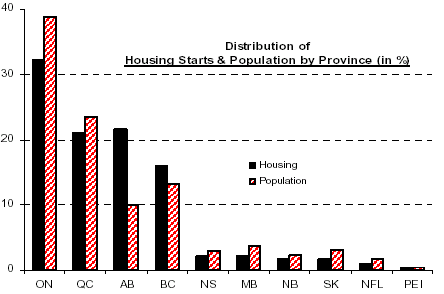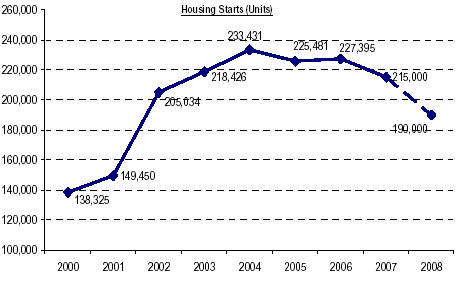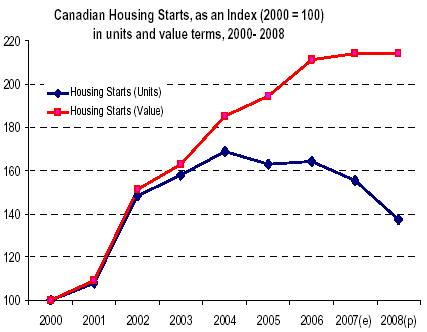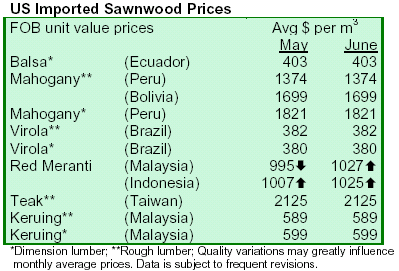|
IWPA testifies on plywood competition at ITC
A panel of International Wood Products Association (IWPA) executives testified before the
International Trade Commission (ITC) on the significance of the international
wood products trade to the U.S. A press release from the IWPA said that six ITC commissioners and staff
queried the IWPA executives on the competitiveness of the plywood industry, in light of recent investigation on U.S.
flooring and hardwood plywood industries. In his statement to the ITC, Brent McClendon, IWPA Executive
Vice President, noted that demand for international wood products helps support U.S. manufacturing, distribution,
retailing and the U.S. consumer.
IWPA is also due to testify on illegal logging issues at an upcoming House Subcommittee on
Fisheries, Oceans, and Wildlife on 16 October. McClendon will respond to legislation introduced by Senator Ron Wyden, a
Democratic Senator from Oregon, which would amend the U.S. Lacey Act to ¡®prohibit the import, sale, or trade in
illegally harvested wood and wood products¡¯ (see www.forestnewswatch.com for further details). A recent
IWPA press release on the issue explained that IWPA applauded Wyden and other senators¡¯ attention to the issue
of illegal logging, but the Lacey Act incorrectly singles out ¡®small family businesses to enforce foreign
laws¡¯ and labeled it ¡®anti-small business and an anti-competitive swipe at a community engaged in fair trade¡¯.
US fall in demand for hardwood products to continue in 2008
The Hardwood Review Express presented an analysis of the impacts of the housing crisis on
hardwood lumber products. The analysis explained that the housing crisis appeared ¡®to be
getting worse¡¯, with further deterioration in homebuilding and buying expected. It noted markets for
hardwood products would depend on the recovery of home building and export markets. The
publication recommended that North American hardwoods could be more resilient by competing in existing overseas markets
to help sustain business in the face of the housing crisis. It suggested that the housing crisis could continue for the
next six months to a year.
Canada¡¯s primary and secondary wood industries expected to slow
Residential construction is by far the most important leading indicator foreshadowing the
business fortunes for virtually all primary and secondary wood industries, from
logging to saw-milling and from furniture to window and door manufacturing. It is therefore appropriate to
take a closer look at the past trends and the likely future path of the housing market, using
Canada as our sample region. Experts believe that the broad underlying trends and
conclusions for the US would not be substantially different.
In 2000, annual starts of residential housing stood at 138,325 units in Canada from where they
experienced an almost uninterrupted growth spurt until the first quarter of
2006, culminating at 244,100 units. However, average annual figures already peaked in 2004.
The heavy overbuilding caused a surplus supply of houses and lead to a complete reversal of the industry¡¯s trends.
Following the first quarter of 2006 annual housing starts dropped noticeably,
falling to an estimated low of 215,000 as of 2007. Similar to the declining housing market in the
US, the hemorrhage in Canada has not yet come to an end. Experts anticipate further declines
next year, possibly to a level below 190,000 units, before rebounding a bit in
2009.
On the positive side, the longer term outlook for the Canadian housing market looks good. The
demographic fundamentals in Canada require an annual addition of approximately 225,000 new
housing units. Also, mortgage rates have not shifted upward significantly and less than in
the US.
In contradiction to the decline of new housing units of 5.5% in 2007 and a further anticipated
decline of about 11.6% in 2008, the resale market for existing houses is doing much better. It
experienced still positive growth this year, and the predicted decline next year will be only in
the 2% range. The re-sale market has a lesser impact on the wood industries. Nevertheless, the
change of ownership of existing houses also triggers a demand for wood products, especially
furniture. Furthermore, the sale of older houses frequently triggers subsequent major
renovation and/or flooring projects.
The provincial distribution of housing starts in Canada is an approximate reflection of the
population in each province. As of 2006, one-third of all new housing unitsbuilt were in Ontario,
and another 21% were in Quebec.

The economic vibrancy of the provinces is also mirrored in the housing statistics. It is not
surprising that housing starts in the fast growing economies of British Columbia
and Alberta are higher than their population share suggests. For instance, Alberta recorded a share of 21% of
housing starts even though the province¡¯s population accounts for only 10% of the Canadian
total. On the other hand, the share of housing construction in the less vibrant
economies of Quebec, Ontario, and the Maritime Provinces is disproportionably low.
Generally speaking, most of Canada¡¯s housing activity is

concentrate in the country¡¯s largest urban centers. The exception to this general rule is provided by Fort
McMurray, Alberta with its enormous influx of workers in the oil and gas industry.
Statistics about new housing starts suffer under an important shortcoming. They lack
indications about the size and kind of housing units (single family housing,
rowhouses, apartment dwellings, etc.), even though it is widely known that the average price and size of
houses is getting larger in North America. This is mitigating the negative impact of the currently declining number of
housing starts. Larger houses require more wood in order to be built and more rooms to be furnished.
Even though Canadian housing starts dropped 7.9% from its peak in 2004 to its present level,
the construction value rose by 15.6% during the same time period. A similar
diverging trend will likely be repeated in 2008 with housing starts declining but the construction value
increasing. Of course, some of the value increase is due to higher prices, but inflation is excluded, the trend in
housing is to become larger and more luxurious.
For Canada as a whole, prices for new residential houses advanced by 21.7% between 2004
and 2007. This average pales in comparison to the price increases in such hot spots
as Edmonton and Vancouver where prices skyrocketed by 62.1% and 43.1% respectively. At the
other end of the spectrum lies Windsor and Sudbury with increases in the 3
to 6 % range.

As of today, the average house price in Canada (MSL resale of existing home) is CAD306,000. The average
price tag in BC is CAD430,000 and in Alberta CAD356,000. The least expensive
houses can be found in Price Edward Island at an average price of CAD132,000
and in New Brunswick at CAD136,000. House prices in Ontario are very close to the national average.
Increases in house prices are more dependent on the type and size of the building, and less on the value of the land.
Compared to the overall price increase of 21.7% between 2004 and 2007, land prices went up only by 17.0%, but
house prices (excluding the value of the property) went up by 23.3%. This fact bodes well for the wood processing
industries.
Canada¡¯s forest in jeopardy
The British Columbia provincial government recently reported on the threat of the mountain pine beetle
infestation to the province¡¯s marketable pine forest, noted TTJ Online. The government
said that the infestation could kill 78% of the pine forests by 2015 if the problem
continues unabated. This, coupled with a recent report by PriceWaterhouseCoopers showing significant
losses (CAD45 million) in Canada¡¯s forest sector, made the situation even more bleak. Most of the losses were
attributed to the weak US housing market and the strong Canadian dollar.


|